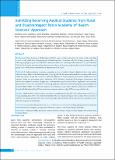Please use this identifier to cite or link to this item:
https://hdl.handle.net/20.500.14356/1627| Title: | Admitting Deserving Medical Students from Rural and Disadvantaged: Patan Academy of Health Sciences’ Approach |
| Authors: | Upadhyay, Shambhu Kumar Bhandary, Shital Bhandari, Dil Bahadur Dulal, Ram Krishna Baral, Kedar Prasad Gongal, Rajesh Nath Acharya, Paras Kumar Shrestha, Shrijana Shah, Jay Narayan Karki, Arjun |
| Citation: | UpadhyayS. K., BhandaryS., BhandariD. B., DulalR. K., BaralK. P., GongalR. N., AcharyaP. K., ShresthaS., ShahJ. N., & KarkiA. (2017). Admitting Deserving Medical Students from Rural and Disadvantaged: Patan Academy of Health Sciences’ Approach. Journal of Nepal Health Research Council, 15(1). https://doi.org/10.33314/jnhrc.v15i1.976 |
| Issue Date: | 2017 |
| Publisher: | Nepal Health Research Council |
| Article Type: | Medical Education |
| Keywords: | Admission OSPE Innovative student selection scheme Nepal Personal Quality Assessment Social Inclusion Matrix |
| Series/Report no.: | Jan-April, 2017;976 |
| Abstract: | Abstract Background: Patan Academy of Health Sciences (PAHS) aims to produce physicians who would be able and willing to serve in the rural areas. Recognizing the critical importance of student selection strategy, among others, in achieving the program goals, it has adopted an innovative scheme for selecting medical students. This paper describes PAHS medical student selection scheme that favors enrollment of deserving applicants from rural and disadvantaged groups so as to help improve distribution of physicians in rural Nepal. Methods: A student admission committee comprising a group of medical educators finalized a three-step student selection scheme linked with scholarships after reviewing relevant literatures and consultative meetings with experts within and outside Nepal. The committee did local validation of Personal Quality Assessment (PQA) that tested cognitive ability and personality traits, Admission OSPE (Objective Structured Performance Examination) that assessed non-cognitive attributes of applicants. It also provided preferential credits to applicants’ socio-economic characteristics to favor the enrollment of deserving applicants from rural and disadvantaged groups through Social Inclusion Matrix (SIM). Three different categories of scholarship schemes namely Partial, Collaborative and Full were devised with Partial providing 50% and other two categories each providing 100% coverage of tuition fee. Results: PAHS student selection scheme succeeded in enrolling more than half of its students from rural areas of Nepal, including about 10% of the students from that of the most backward region of the country. About one third of students were female and about the same were from public and community school. Sixty percent of students receive different categories of scholarships. Conclusions: Limited findings indicate the success of the selection scheme in enrolling high proportion of applicants from rural and disadvantageous groups and enable them to pursue study by providing scholarships. Keywords: Admission OSPE; innovative student selection scheme; Nepal; Personal Quality Assessment; Social Inclusion Matrix. |
| Description: | Medical Education |
| URI: | http://103.69.126.140:8080/handle/20.500.14356/1627 |
| ISSN: | Print ISSN: 1727-5482; Online ISSN: 1999-6217 |
| Appears in Collections: | Vol. 15 No. 1 Issue 35 Jan-Apr 2017 |
Files in This Item:
| File | Description | Size | Format | |
|---|---|---|---|---|
| 976-Manuscript-1909-1-10-20170608.pdf | Fulltext Download | 184.15 kB | Adobe PDF |  View/Open |
Items in DSpace are protected by copyright, with all rights reserved, unless otherwise indicated.
